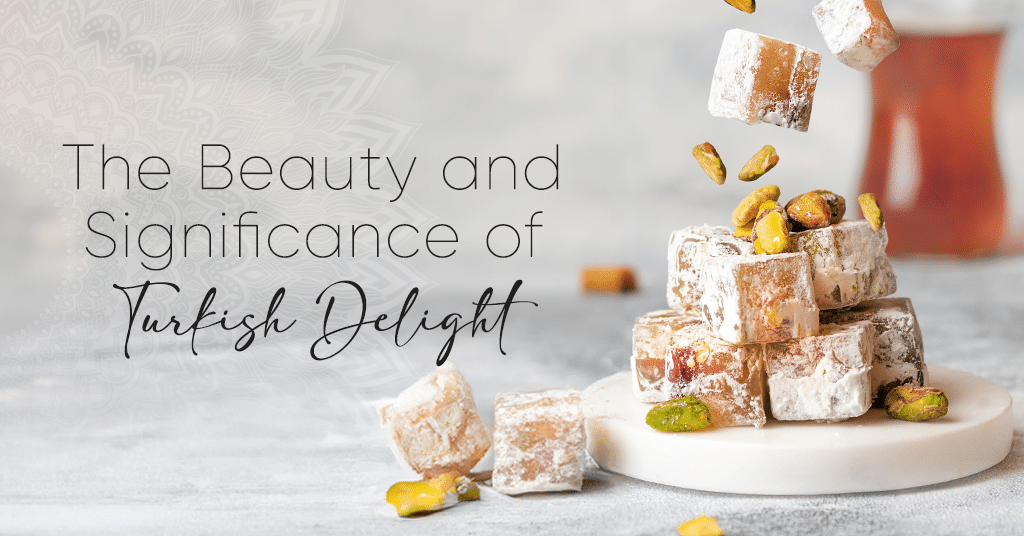
More than just a dessert, Turkish delight, or “lokum” as it is known in Turkish, is a treat with a fascinating history to match its flavorful aromas. Turkish Delight has delighted lips and palates for ages, from its beginnings in Ottoman Empire to its current global renown.

The allure of Turkish delight extends far beyond its delicious taste. Some might remember the treat from C.S. Lewis’s classic tale, “Chronicles of Narnia,” in which the Turkish delight plays a role. The character of the White Witch, Jadis, offers the delectable treat to the young Edmund Pevensie, using it as a tempting bribe in exchange for information. This portrayal of Turkish delight in a fantasy setting added to its allure, making it even more intriguing to readers and viewers.
But what exactly is Turkish delight, and how did it become a symbol of temptation in the world of Narnia?
Turkish Delight History
Turkish Delight is a culturally significant treat that goes back hundreds of years, to the days of the Ottoman Empire, often flavored with rosewater, mastic, or citrus extracts, resulting in a fragrant and aromatic delight. These classic flavors provide a glimpse into the historical roots of the confection, as they were used in the earliest versions enjoyed by Ottoman sultans and their courts.
Like mention before, origins of lokum can be traced back to the lavish palaces of the Ottoman Empire. It’s said that the treat was created during the reign of Sultan Mehmet II in the 15th century. The sultans and their courts sought treats that would reflect the prestige and exoticism of their empire. The creation of lokum was a result of their experiments.
The earliest versions of Turkish delight were quite different from what we know today. They were typically made from honey and molasses and flavored with herbs, spices, and flower extracts. Rosewater, a classic and still-beloved flavor, was one of the most famous historical ingredients used.

Turkish Delight Evolution and Diversification
Over time, Turkish delight has evolved to include a diverse range of flavors and ingredients, ensuring it remains a treat that can satisfy a wide range of tastes. While the classic rose flavor remains beloved, you can now find an array of options, including orange blossom, lemon, pomegranate, and even chocolate. The addition of chocolate, with its rich, creamy taste, has broadened the appeal of lokum, making it an even more decadent treat for chocolate enthusiasts.
But how is this delectable delight made? What are the ingredients and the secrets to its chewy yet delicate texture?
The Ingredients and Recipe:
If you’re intrigued by the idea of making Turkish delight at home, it’s entirely possible, though it does require patience and precision. The main ingredients for traditional lokum include sugar, water, and starch, typically cornstarch or potato starch.
Here’s a detailed Lokum recipe to guide you through the process:
Ingredients:
- 2 cups of granulated sugar
- 1 cup of water
- 1/2 cup of cornstarch
- 1/2 cup of water (for the cornstarch mixture)
- 1/4 teaspoon of cream of tartar
- 1 to 2 teaspoons of flavor extract (rosewater, lemon, or any preferred flavor)
- Food coloring (optional)
- Chopped pistachios, walnuts, or almonds for coating (optional)
Instructions:
- 1- In a saucepan, mix the sugar and one cup of water. Bring to a boil, then reduce the heat and simmer until it reaches the soft-ball stage (around 240°F or 116°C).
- 2- In a separate bowl, mix the cornstarch, 1/2 cup of water, and cream of tartar until smooth.
- 3- Slowly pour the cornstarch mixture into the sugar syrup while stirring constantly. Cook, stirring, until the mixture thickens and becomes translucent.
- 4- Add your chosen flavor extract and food coloring, if desired.
- 5- Pour the mixture into a greased and cornstarch-dusted pan. Let it cool and set for a few hours or overnight.
- 6- Cut the set Turkish delight into bite-sized pieces and coat them with chopped nuts if you like.
Enjoy your homemade Lokum!

Cultural Impact:
In Turkey, Lokum is not just a sweet treat; it’s an integral part of the culture. It is often associated with hospitality and is traditionally offered to guests as a sign of warmth and welcome. During holidays, weddings, and other celebrations, Turkish delight is a common offering, symbolizing the sweet moments in life.
The colorful boxes of Turkish delight that can be found in Turkish bazaars are not just a sight for tourists; they are often exchanged as gifts and tokens of appreciation. This cultural significance has contributed to the enduring popularity of Turkish delight both in its home country and abroad.
Speaking of, one of the remarkable features of lokum is its ability to transcend cultural and physical boundaries and win the hearts of people from all corners of the world. Its sweet, aromatic, and chewy nature makes it an attractive option for those looking to explore new culinary horizons.
Even in it’s history, the allure of Turkish delight did not remain confined to the borders of the Ottoman Empire. Travelers, explorers, and traders introduced this delightful confection to Europe and beyond. In the 19th century, it gained popularity in Western countries and became a coveted treat for those seeking exotic flavors and textures. Today, you can find Turkish delight in stores and markets around the world, continuing its global journey.
In Europe, it’s a favorite treat during the festive holiday season. You’ll often find it adorning dessert tables or packaged in beautifully decorated boxes, making it a popular choice for gifting.
In the Middle East, it remains a symbol of hospitality and is often offered to guests in homes and businesses. The tradition of enjoying Turkish delight with a cup of fragrant tea or coffee is a cherished custom in the region.
In North America, Lokum has become a part of the multicultural culinary landscape. Its unique combination of flavors and textures appeals to the adventurous palates of those seeking new taste experiences.
Turkish delight in the modern day is not just a candy; it’s a cultural ambassador. It has transcended geographical boundaries, showcasing the rich history and flavors of Turkey to people from diverse backgrounds. In cosmopolitan cities like Istanbul, the confection is readily available, with shops offering a wide array of flavors and packaging options to cater to both locals and tourists. People who don’t even know Turkey’s capital city (it’s Ankara by the way) know about Lokum!

Modern Varieties:
While the classic flavors of rosewater, mastic, and citrus still hold a special place in the hearts of Turkish delight enthusiasts, the confection has undergone a transformation over the years. Today, you can explore a dazzling array of flavors, each offering a unique taste sensation.
This diversification of flavors allows lokum to cater to a broader audience, ensuring that there is something for everyone. Whether you prefer the traditional rosewater, the zesty citrus varieties, or the more contemporary chocolate-infused delights, there’s a Turkish delight to satisfy your cravings.

Beyond its flavors and origins, Turkish delight is often associated with fond memories. For many, it evokes nostalgia for a time when they first encountered the treat, perhaps during a visit to a Turkish market or while reading about Edmund’s adventure in Narnia. The delightful flavors and fragrances of Turkish delight have the power to transport people to different places and times, making it a unique and cherished confection.
Turkish delight is more than a candy; it’s a sweet journey through history, culture, and the senses. Its origins in the Ottoman Empire, portrayal in literature, diverse flavors, and global appeal contribute to its enduring popularity. From the traditional rosewater delights to the modern chocolate-infused variations, Turkish delight continues to captivate people’s taste buds and hearts.

So, the next time you savor a piece of Turkish delight, remember that you’re enjoying a confection with a history as rich and diverse as its flavors. Let it transport you to distant lands, evoke cherished memories, and indulge in the delightful journey it offers.
With its captivating history and global appeal, lokum is a confection that transcends time and place, providing a sweet escape and a delightful experience for all who partake in its flavors.
Explore the finest Turkish Delight, rich in cultural heritage and flavor, by visiting our Turkish Delights category. Now, the most delicious treats from the Turkish bazaar can arrive at your door in just 2 days.











 Home
Home  Whishlist
Whishlist  Compare
Compare  Checkout
Checkout